
What is Concrete Pumping and How Does It Work?

Concrete pumping has changed the way contractors place concrete on job sites. Rather than hauling heavy loads in wheelbarrows or relying on cranes and buckets, a concrete pump delivers liquid concrete through a system of hoses, pipes, or booms—directly to the point of placement. This method allows for faster work, tighter quality control, and more efficient coordination, especially on complex or large-scale projects.
What Is Concrete Pumping?
At its core, concrete pumping is the process of moving freshly mixed concrete from the truck to its final location using hydraulic pressure. After the mix is poured into a hopper at the rear of the pump, two alternating cylinders—powered by hydraulics—work in tandem. As one piston draws concrete into its chamber, the other pushes it out through a valve and into the pipeline. This cycling motion creates a steady flow of concrete that can be directed vertically or horizontally. The pump’s reliability lies in this simple but effective mechanism, which enables continuous placement with minimal interruption.
Types of Concrete Pumps: Boom and Line Pumps
Two main types of concrete pumps are used across the industry: boom pumps and line pumps.
Boom Pumps
Boom pumps are mounted on trucks and feature a multi-section robotic arm that can extend over rooftops, around obstacles, or up multiple stories. These are the preferred choice for elevated slabs, tilt-wall panels, and projects with restricted access from the ground level. Their reach often spans over 100 feet, and some models exceed 200, making them essential for mid- to high-rise construction.
Line Pumps
Line pumps operate using flexible hoses or rigid pipes that can be routed through tight site conditions. These are common on residential foundations, interior pours, and renovation work. Output rates vary, typically between 30 to 90 cubic yards per hour, depending on pump size and line length. Their compact footprint and fast setup—often under an hour—make them ideal for urban sites or properties with minimal access.
Choosing Based on Site Needs
For example, a boom pump might be required to reach a third-floor deck without needing scaffolding, while a line pump may be better suited for placing concrete along a winding garden path or through a basement window. Choosing the right pump involves evaluating site logistics, required volume, vertical reach, and available crew size.
Effective Setup Strategies for Concrete Pumping
How does concrete pumping work in real-world applications? It starts with a detailed site evaluation. Boom pumps require level ground and space for outriggers to stabilize the vehicle. Line pumps need a clear path for hose or pipe layout, with considerations for bends, elevation changes, and access points. On flat residential sites, a 200-foot line can be laid in under 30 minutes. On sloped or congested terrain, extra crew may be needed to secure or support lines. The right setup minimizes rework, speeds up pouring, and ensures consistency across the job.
Placement Coordination and Real-Time Control
A standard pump crew includes an operator and two to three placement technicians. The operator manages pump speed, flow pressure, and—in the case of boom pumps—the arm movement. Wireless remotes allow for real-time communication between crew and operator, which is critical when working around complex rebar configurations or forms that demand slow, steady pours. Adjustments can be made instantly based on mix behavior, slump variation, or form movement. This coordination ensures complete coverage while reducing waste and spillage.
Pump Output and Performance Variables
Modern concrete pumps allow for fine-tuned control of delivery rate, typically adjustable from 20 to 120 cubic yards per hour. These settings are based on mix design, hose length, vertical lift, and form geometry. Longer line runs—especially those over 300 feet—may require higher initial pressure and water reducers in the mix to prevent blockages or segregation. In tight forms, lower pump pressure helps avoid blowouts or excessive vibration. Understanding these variables ensures a cleaner, more consistent finish and protects both the formwork and reinforcing steel.
Pumping with Insulated Concrete Forms

Pumping concrete into insulated concrete forms (ICFs) like those from Fox Blocks requires careful attention to flow rate, lift height, and pressure settings to avoid form deformation or incomplete fills. ICF walls typically receive concrete in 4-foot lifts, allowing time for internal consolidation and pressure equalization. Using a line pump with a 2-inch or 2.5-inch reducer at the discharge helps control velocity and reduce internal surge within the form cavity.
The goal is to maintain around 100 to 150 feet per minute vertical rise to ensure the concrete flows around rebar and ties without creating air pockets. With proper hose handling and continuous monitoring, concrete pumping supports faster ICF construction while preserving thermal integrity and structural strength throughout the wall assembly.
Accuracy, Speed, and Structural Quality
Concrete pumping allows for continuous placement, which is vital when aiming to avoid cold joints in structural walls, floors, or decks. With traditional methods, time gaps between batches often lead to differential curing, which weakens the bond between lifts. Pumping eliminates that problem by delivering a steady flow that maintains hydration between passes. This reduces air pockets and improves internal consolidation, leading to stronger, more durable concrete. For contractors working on tight timelines, this consistency shortens curing delays and reduces the need for patching.
Safety and Site Management
By eliminating the need to transport concrete manually across uneven or congested terrain, pumping significantly improves jobsite safety. Crews no longer have to maneuver heavy wheelbarrows through muddy or obstructed paths, reducing trip hazards and fatigue. Boom pumps can place concrete from a safe distance, keeping the machinery out of the main work area.
Line pumps are quiet, low-emission, and less disruptive on residential jobs, especially in noise-sensitive areas. Keeping staging equipment away from the main workspace also prevents traffic conflicts with other trades, helping general contractors maintain schedule coordination.
Building Performance and Energy Efficiency
A uniform concrete pour plays a direct role in the long-term performance of a structure. When used with insulated concrete forms, proper pumping ensures that all interior cavities are filled without gaps or settling. This uninterrupted fill contributes to a stronger thermal barrier and eliminates weak points that would otherwise affect energy performance. Projects targeting Net Zero standards or low HERS (Home Energy Rating System) scores depend on this level of precision. It supports tighter building envelopes, better temperature regulation, and fewer air leaks.
Comfort Backed by Construction Integrity
Builders often ask, “how does concrete pumping work?” but what they’re really seeking is how it benefits the end user. The answer lies in comfort and consistency. Structures poured with precision maintain stable indoor temperatures thanks to the thermal mass of the concrete. In hot climates, this mass helps moderate interior heat spikes. In colder zones, it slows heat loss overnight. The result is improved HVAC efficiency and more consistent year-round comfort for occupants.
Smarter Building with Modern Pumping Techniques

Concrete pumping has become more than a convenience—it’s now a construction standard. As code requirements grow stricter and performance targets become more demanding, accurate, high-speed placement becomes increasingly important. Placing stem walls, elevated decks, or ICF cores—pumping helps save time, reduce errors, and support higher building standards. Crews can place more concrete with fewer people in less time, all while meeting exacting design specifications.
Build Stronger, Smarter Structures with Fox Blocks and Concrete Pumping
Contractors choosing Fox Blocks insulated concrete forms already benefit from superior energy efficiency, airtightness, and structural resilience. When paired with smart concrete placement strategies like concrete pumping, every inch of the form is filled precisely, helping ensure optimal performance, faster installation, and long-term occupant comfort. Contact us today and speak with one of our experts.